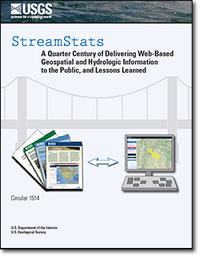StreamStats—A Quarter Century of Delivering Web-Based Geospatial and Hydrologic Information to the Public, and Lessons Learned
Links
- Document: Report (7.67 MB pdf) , HTML , XML
- Download citation as: RIS | Dublin Core
Abstract
StreamStats is a U.S. Geological Survey (USGS) web application that provides streamflow statistics, such as the 1-percent annual exceedance probability peak flow, the mean flow, and the 7-day, 10-year low flow, to the public through a map-based user interface. These statistics are used in many ways, such as in the design of roads, bridges, and other structures; in delineation of floodplains for land-use zoning and setting of insurance rates; for regulatory purposes, such as the permitting of wastewater discharges; and for hydrologic and climate change studies. StreamStats was first developed for Massachusetts and released in 2001. The application provided users with the ability to obtain streamflow statistics computed from data collected at USGS streamgages and to obtain estimates of streamflow statistics for user-selected ungaged sites. Massachusetts StreamStats used geographic information system software and digital mapping to compute drainage-basin characteristics, which were then used in statistical models to estimate streamflow statistics for the user-selected sites. The statistical models were in the form of equations that were developed through a process known as regression analysis. StreamStats was the first known web application with the ability to do interactive geoprocessing.
The utility of Massachusetts StreamStats was instantly apparent, leading the USGS to develop a version of StreamStats that could be implemented nationally. USGS State offices normally were required to develop custom regression equations and prepare local digital mapping data needed for implementing StreamStats for their States. Funding needed to complete this work usually was provided through cooperative agreements between the USGS and State agencies. In 2004, Idaho became the first to be released in the national version of StreamStats. By 2023, 44 States were fully implemented and six were undergoing implementation.
StreamStats has undergone many modifications over the years to keep up with changes to the underlying software and to add functionality. Customized functionality and separate linked StreamStats applications were developed for several States. Meeting the high demand for additions and improvements to StreamStats while also adhering to budgetary constraints has, at times, been challenging. The StreamStats development team has identified numerous additional improvements that could be made to provide better performance and more functionality. The lessons learned from the experience of building and operating StreamStats for nearly 25 years could be relevant to others interested in pursuing efforts of a similar scale.
Suggested Citation
Ries, K.G., III, Steeves, P.A., and McCarthy, P., 2024, StreamStats—A quarter century of delivering web-based geospatial and hydrologic information to the public, and lessons learned: U.S. Geological Survey Circular 1514, 40 p., https://doi.org/10.3133/cir1514.
ISSN: 2330-5703 (online)
ISSN: 1067-084X (print)
Table of Contents
- Acknowledgments
- Abstract
- Introduction
- Initial Concept
- Going National
- Keeping Up With Technology and User Needs
- Further StreamStats Enhancements
- Lessons Learned
- Summary
- References Cited
| Publication type | Report |
|---|---|
| Publication Subtype | USGS Numbered Series |
| Title | StreamStats—A quarter century of delivering web-based geospatial and hydrologic information to the public, and lessons learned |
| Series title | Circular |
| Series number | 1514 |
| DOI | 10.3133/cir1514 |
| Publication Date | March 13, 2024 |
| Year Published | 2024 |
| Language | English |
| Publisher | U.S. Geological Survey |
| Publisher location | Reston, VA |
| Contributing office(s) | WMA - Integrated Modeling and Prediction Division |
| Description | viii, 40 p. |
| Online Only (Y/N) | N |
| Additional Online Files (Y/N) | N |


